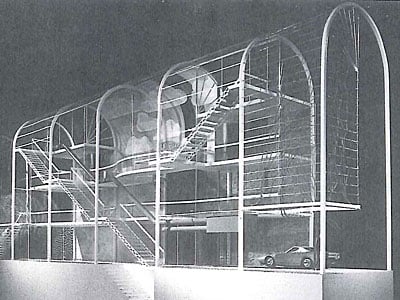The Chicago Seven
In 1976, a group of Chicago architects joined forces to start a postmodern group in protest of a Miesian architectural movement taking over Chicago. Believing an art exhibit at the Museum of Contemporary Art, One Hundred Years of Architecture in Chicago, distorted reality because of the strong emphasis on Ludwig Mies van der Rohe, the architects began planning their own exhibits and shows. This proved to be the impetus for their national recognition. The Exquisite Corpse exhibition showcased the architects’ abandonment of modernist rules and resulted in the production of variations of Chicago townhomes.
The Exquisite Corpse

Thomas Beeby entry in Exquisite Corpse

Helmut Jahn entry in Exquisite Corpse

Stanley Tigerman entry in Exquisite Corpse

Cynthia Weese entry in Exquisite Corpse
Over the years, additional architects joined the Chicago Seven movement (Halmut Jahn, Gerald Horn, Kenneth Schroeder, and Cynthia Weese). Beeby once said of this group however: “They didn’t agree on anything.”
Along with Thomas Beeby, here is the original Chicago Seven:
Stanley Tigerman
Stuart Cohen

Photo credit: Stuart Cohen, FAIA
Larry Booth
A graduate of the Massachusetts Institute of Art, Harvard University, and Stanford, Booth believes: “spirited, meaningful, and useful buildings can be realized with an organized and open creative process.”
Ben Weese

Photo credit: Ben and Cynthia Weese
James Ingo Freed
The only original Chicago Seven member born outside of the United States, Freed’s body of work includes The United States Holocaust Memorial Museum, the Ronald Reagan Building and International Trade Center, Jacob K. Javits Convention Center in New York City and the United States Air Force Memorial. Freed is a graduate of the Illinois Institute of Technology.
James Nagle
A graduate of Stanford, M.I.T., and Harvard, Negle’s work includes the Greyhound Bus Terminal (Chicago), Kinzie Park Tower (Chicago), the Homan Square Housing (Chicago), and the Dallas Courtyard House (Dallas).







